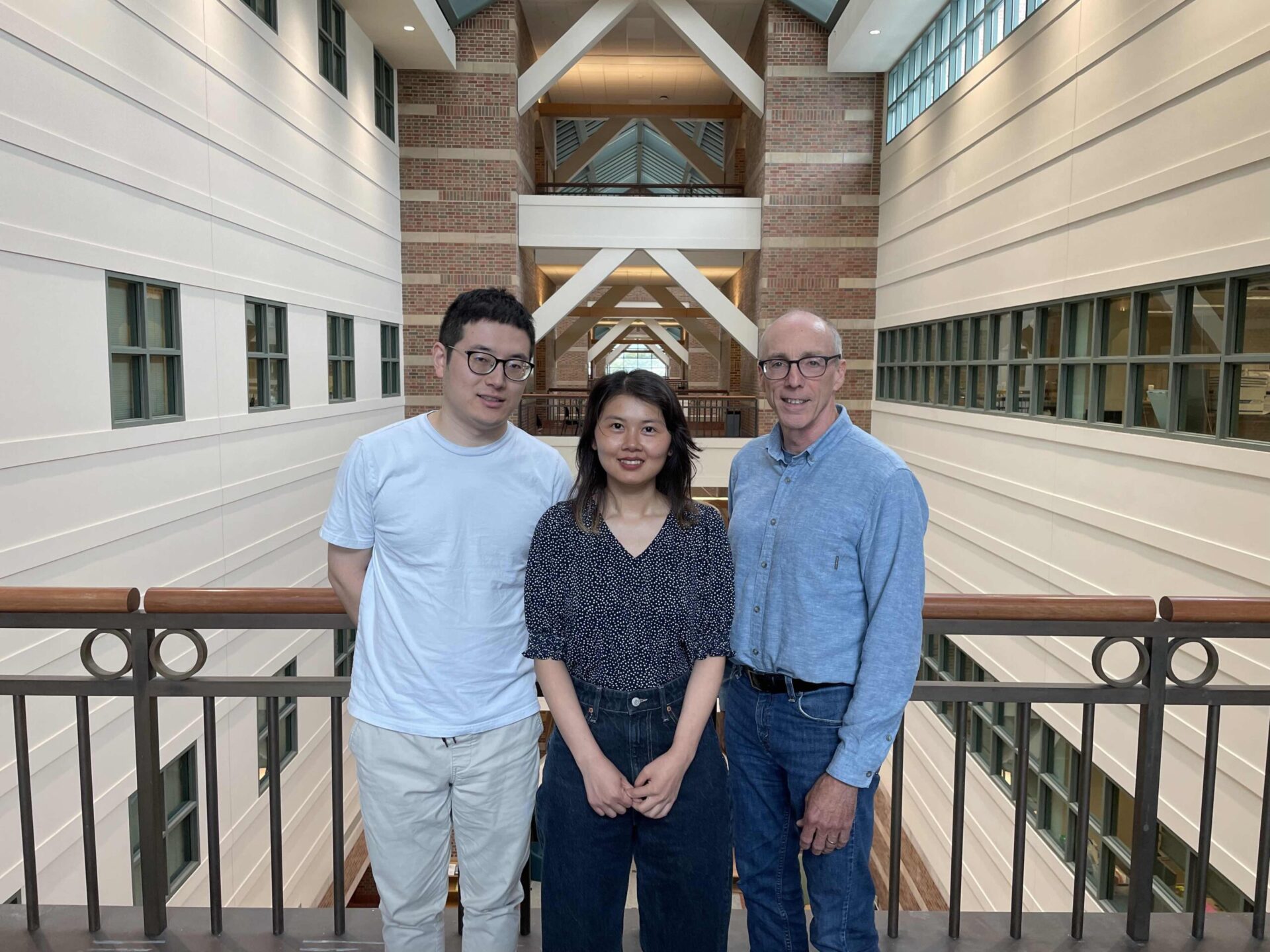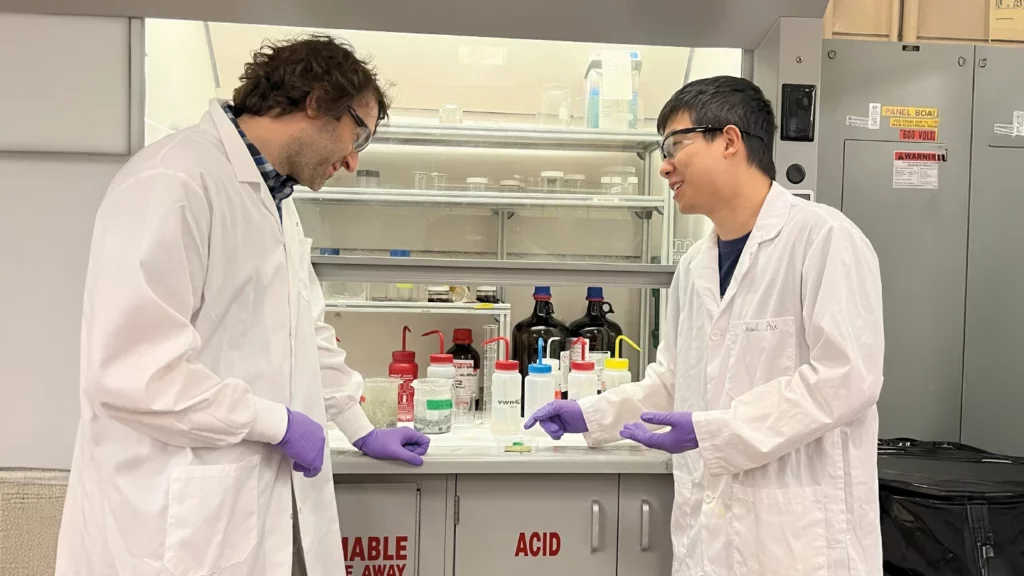Researchers from the Moore Group in the Department of Chemistry at the University of Illinois have developed a dual C–H functionalization strategy that transforms waste oligomer fragments from recycled carbon fiber-reinforced polymers (CFRPs) into high-performance, reprocessable materials.
In our earlier feature, we explored how their electrochemical approach enables the upcycling of polymer byproducts that would otherwise be discarded or used as low-value fillers. Now, we sat down with Yuting Zhou and the team at Illinois to discuss the motivations behind targeting oligomer fragments, the design of their dual C–H functionalization method, and the performance and durability tests confirming the success of their upcycled materials.
Follow some of the authors here:
You can see the full research paper here:
Zhou, Y., Xu, Z., & Moore, J. S. (2025). Dual C–H functionalization of polyolefins for covalent adaptable network formation via cooperative electrolysis. Nature Synthesis. https://doi.org/10.1038/s44160-025-00876-7
The following interview is presented unedited to preserve the original insights of the researchers, offering an in-depth look at how the Moore Group integrated electrochemistry and polymer chemistry to build covalent adaptable networks from CFRP waste — setting a foundation for scalable, energy-efficient composite recycling and sustainable material innovation.
Acknowledgments from Yuting Zhou and the team at the Moore group: This work was supported as part of the REMAT EFRC, an Energy Frontier Research Center funded by the US Department of Energy, Office of Science, Basic Energy Sciences at the University of Illinois Urbana–Champaign under award no. DE-SC0023457. The authors acknowledge the Beckman Institute for Advanced Science and Technology and the School of Chemical Sciences NMR Laboratory at UIUC for their support.
What inspired you to target oligomer fragments from carbon fiber-reinforced polymer (CFRP) waste rather than discarding them or using them as fillers, and how did you evaluate which functionalizations would best restore performance?
The primary goal in recycling carbon fiber composites has traditionally been the recovery of high-value carbon fibers, but this process inevitably generates a byproduct stream of oligomer fragments. These fragments represent a significant portion of the composite’s total volume, and discarding them undermines the sustainability of the overall recycling process. To achieve a truly net-zero-waste manufacturing ecosystem, it is essential to valorize these byproducts rather than treating them as waste or low-value fillers.
The functionalizations we pursued were guided by the inherent chemical structure of the recycled polyolefin fragments. Because these materials contain abundant allylic C–H sites, we focused on strategies that target those positions. Allylic C–H functionalization provides a powerful handle to introduce new chemical functionalities and restore the structural and performance characteristics necessary for high-value material applications.
Could you explain the process of dual C–H functionalization used in your electrochemical method: what types of C–H sites you found most reactive, how you introduce the new functional groups, and how that enables crosslinking into a covalent adaptable network?
Our approach leverages electrolysis to activate the redox mediator N-hydroxyphthalimide (NHPI), which facilitates radical-mediated C–H activation of the allylic sites along the polymer backbone. Through this oxidative pathway, we introduce α,β-unsaturated ketone groups onto the polymer chains. Simultaneously, NHPI also participates as a reagent in a paired electrochemical reduction process, enabling the installation of phthalimide groups onto the same backbone.
The coexistence of these complementary functional groups is key: they can undergo dynamic covalent reactions with one another, linking the oligomer fragments into covalent adaptable networks (CANs). These dynamic networks exhibit strong mechanical properties, respond to external stimuli, and can be reshaped or reprocessed — restoring the value of the recycled material.
What mechanical, thermal, and reprocessing tests did you conduct to quantify performance gains in the upcycled material compared to the untreated oligomers, and what trade-offs (e.g. flexibility vs stiffness) were observed?
We conducted dynamic mechanical analysis (DMA) on both untreated and functionalized oligomers. The untreated fragments melted as temperature increased, indicating poor network integrity. In contrast, the functionalized materials exhibited restored storage modulus and significantly higher glass transition temperatures, reflecting improved network structure and enhanced thermal stability.
We also performed swelling and dissolution tests to probe the reversibility, reprocessability, and overall stability of the new networks. These experiments confirmed that the covalent adaptable networks could undergo reversible bond exchange while maintaining robust mechanical performance.
How scalable is your electrochemical method in terms of oligomer concentration, electrode design, and energy input? What bottlenecks do you anticipate in moving from lab-scale to pilot or industrial scale?
Electrochemistry inherently offers excellent scalability, as it replaces stoichiometric chemical oxidants with electricity and allows reaction rates to be tuned simply by adjusting current density, electrode surface area, and reactor geometry. We have successfully demonstrated our dual C–H functionalization method on the deca-gram scale and maintained high reaction efficiency even at elevated oligomer concentrations.
That said, several challenges must be addressed before industrial implementation. The high viscosity of oligomer solutions demands careful reactor and electrode design to ensure efficient mass transport and minimize concentration polarization. Electrode fouling over extended operation is another consideration. Finally, energy optimization will be critical — integrating renewable electricity sources and improving catalytic turnover will help reduce both operating costs and environmental impact.
In exploring other materials beyond those derived from CFRPs, what challenges have you encountered (or expect) when applying the same dual C–H functionalization to different polymer backbones or oligomer compositions?
The structure of the polymer backbone has a profound effect on C–H reactivity and functionalization outcomes. Saturated polyolefins, for instance, contain fewer reactive sites and often require more aggressive activation conditions compared to allylic or benzylic systems.
To broaden the applicability of our approach, we are adapting our cooperative electrolysis method to other backbones, such as polybutadiene — an important synthetic rubber component. Our published work already includes exploratory data demonstrating the successful functionalization of polybutadiene, highlighting the potential to extend this strategy to a wider range of polymer chemistries.
How has collaboration within the REMAT EFRC and with other researchers or industry partners influenced your choices of polymer types, functional groups, or evaluation metrics?
The collaborative environment within the REMAT EFRC has been instrumental in shaping both the scientific scope and the practical direction of this research. Interdisciplinary partnerships — particularly with engineering teams — have broadened how we define and evaluate success.
Looking forward, what lifecycle, durability, or environmental stability tests do you plan (e.g. UV exposure, moisture, fatigue) to ensure that these upcycled materials will perform reliably in real-world applications?
Durability studies under UV exposure, moisture, and thermal cycling, along with long-term reprocessing tests, are critical evaluation metrics for assessing the reliability of these new materials in real-world applications. Such tests reveal how the upcycled materials perform under practical environmental conditions and how their properties evolve with repeated use, ensuring that they remain both sustainable and reliable over time.

Hassan graduated with a Master’s degree in Chemical Engineering from the University of Chester (UK). He currently works as a design engineering consultant for one of the largest engineering firms in the world along with being an associate member of the Institute of Chemical Engineers (IChemE).



